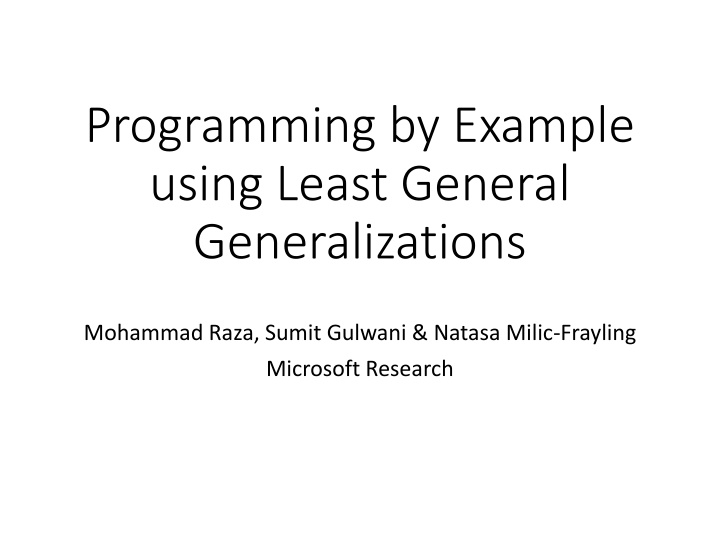
Programming by Example Using Least General Generalizations
Programming by Example (PBE) has advanced significantly, especially in addressing transformations on small unstructured text strings. Existing approaches face challenges in scaling to complex editing scenarios like richly formatted document editing. The concept of Least General Generalizations and recent DAG-based approaches are discussed as potential solutions to these challenges.
Download Presentation

Please find below an Image/Link to download the presentation.
The content on the website is provided AS IS for your information and personal use only. It may not be sold, licensed, or shared on other websites without obtaining consent from the author. If you encounter any issues during the download, it is possible that the publisher has removed the file from their server.
You are allowed to download the files provided on this website for personal or commercial use, subject to the condition that they are used lawfully. All files are the property of their respective owners.
The content on the website is provided AS IS for your information and personal use only. It may not be sold, licensed, or shared on other websites without obtaining consent from the author.
E N D
Presentation Transcript
Programming by Example using Least General Generalizations Mohammad Raza, Sumit Gulwani & Natasa Milic-Frayling Microsoft Research
Introduction Programming by Example (PBE) has made significant advances recently, e.g. Excel Flash Fill (Gulwani 11) Addressing transformations on small unstructured text strings
Introduction Existing approaches do not scale to more complex editing scenarios e.g. richly formatted document editing PBE paradigm is well-suited to rich formatting scenarios: Styles, templates are restrictive and require premature commitment from the user Macro programming languages are expressive but too advanced for most users Discoverability of specialised features is difficult in complex UIs
Repetitive formatting scenarios Colour all objects with underlined text Colour all diamond- shaped objects Initial state
Repetitive formatting scenarios Initial state Align all pictures Shift all pictures
Repetitive formatting scenarios Change all first names to initials
Repetitive formatting scenarios Change all first names to initials
Challenges & existing approaches General PBE ingredients: Domain specific language (DSL) - space of possible programs Synthesis algorithm - given input-output examples, infer a satisfying program in the DSL Trade offs between expressivity of DSL, efficiency and accuracy of synthesis algorithm Recent DAG-based approaches: Construct an explicit representation of all possible programs followed by ranking within this space 1 P K
A different approach to PBE Since goal is to find a single program, can we incorporate the ranking strategy implicitly into the synthesis algorithm? Adopting the notion of least general generalization from inductive inference (Plotkin 70): Design a DSL equipped with a natural subsumption ordering on programs Design an algorithm that efficiently generates programs that are minimal with respect to the subsumption ordering Avoid exhaustive enumeration of the search space
Domain Specific Language Structured representation of richly formatted content (XML) Change all text boxes that have Arial font of size 12 into a red coloured table Example input state Example output state DSL programs express conditional transformations on XML trees: Input expression Output expression
Domain Specific Language Data model XML represented as ordered trees Each node labelled by an element name a mapping of attributes to literal values DSL Programs defined by input and output tree expressions Attribute value expressions may be specified by literals, variables or function expressions e.g. numeric or text transformations Loop expressions using iterators Expressing structural variations May be nested Unique loop expression per element in a sibling composition
Semantics Match the input expression to get a substitution for variables and iterators, then apply that substitution to the output expression Substitutions? Subs map variables to literals and iterators to a sequence of substitutions Match and Apply defined recursively over tree structure Substitutions inform the subsumption ordering:
Synthesis algorithm Given a set of input-output examples, generate a program satisfying all the examples that is minimal in the subsumption ordering Based on syntactic anti-unification (Plotkin 70) Using scopes to represent nested loop contexts: maintain injective maps for generating variables and iterators within scopes
Synthesis algorithm top level Overall approach Generalize over inputs Generalize over outputs Relate variables between input and output
Synthesis algorithm Inferring tree expressions Select next element e from top level siblings Call recursively on remaining siblings If e has fixed number occurrences then infer rooted tree expression Otherwise introduce a new iterator and infer loop expression
Synthesis algorithm Infer rooted tree expression Follows inductive structure Infer attribute map expression (base case) Introduce new variable if attribute values not consistent
Evaluation Implemented an add-in for Microsoft PowerPoint, based on OOXML file format Evaluated with questions from online help forums Questions covered wide range of PowerPoint features e.g. shapes, images, charts, tables, bullets, margins, fonts, borders, size, positioning, scaling, colors, styles, indents indent any text of a certain font if it appears inside a table change only red coloured circular shapes change only text of a certain font and size borders around all pictures change paragraphs to table rows Some tasks involving ranges not expressible Average of 4.2 examples required for task completion
Conclusion Extended applicability of PBE to domain of rich formatting transformations LGG provides a different approach to PBE where DSL is designed with respect to a target subsumption relation ranking bias is implicit in the synthesis algorithm Next steps: Targeting more expressive domains (e.g. ranges in conditionals, loop conditions) Faster convergence (customizing XML formats) Natural interaction techniques, e.g. NL input from user to target more expressive domains with fewer examples


